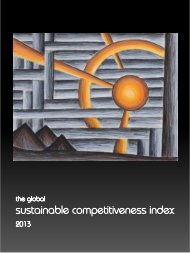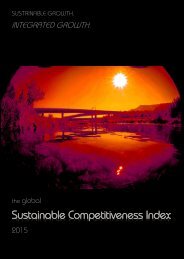The Global Sustainable Competitiveness Index 2019
Measuring competitiveness comprehensively: Sweden & Scandinavia tops, Germany #15, UK 17, US 34, China 37 in the Global Sustainable COmpetitiveness Index 2019
Measuring competitiveness comprehensively:
Sweden & Scandinavia tops, Germany #15, UK 17, US 34, China 37 in the Global Sustainable COmpetitiveness Index 2019
You also want an ePaper? Increase the reach of your titles
YUMPU automatically turns print PDFs into web optimized ePapers that Google loves.
Methodology
Table of
Contents
Methodology Development
The competitiveness of a nation is influenced by a wide range of factors, i.e. is a
complex matter. We are striving to develop a model that can reflect all aspects
that define the level of competitiveness. The methodology for the Sustainable
Competitiveness is therefore constantly reviewed and has evolved over time.
The changes to the Sustainable Competitiveness Model and indicators have
been undertaken based on past experiences, new research, data availability,
and back-track analysis.
We prioritise accuracy over consistency. Due to changes in methodology, yearon-year
comparison of rankings have a somewhat limited informative value.
From an index point of view, it might be preferable to base rankings on the same
methodology and data. However, we believe that delivering the most accurate
result possible is more important than direct of year-on-year rankings
comparison. The main changes that have been implemented as a result of the
methodology review include changes to the model of competitiveness on which
the calculation is based, and further adaptation to availability of congruent
data series.
The sustainable competitiveness model has been adapted to better reflect the
elements that characterise and influence sustainable competitiveness of nationeconomy,
and how those elements influence and impact each other. The
model used for the first Index consisted of 4 key elements – Natural Capital,
Resource Intensity, Sustainable Innovation, and Social Cohesion. Since 2014, the
Sustainable Competitiveness model is based on a pyramid with 5 levels. The
basic conditions form the basis of the pyramid, on which the next level is built.
Vice-versa, the higher levels of the pyramid are influencing the performance of
the levels below.
• The base level of the Pyramid is the Natural Capital (the given physical
environment and resources) – the resources that feed the population,
provide energy, and materials
• The second level is Resource Management – the ability to use available
resources at the highest possible efficiency - natural resources, human
resources, intellectual resources, financial resources.
• The third level is the Social Capital of a country, the cohesion between
generations, genders, income groups and other society groups. Social
cohesion is required for the prosperous development of human capital,
i.e. Social Capital is the provision of a framework that facilitates the third
level of the pyramid
• The fourth level is the Intellectual Capital, the fundament for the ability to
compete and generate wealth in a globalised competitive market
through design and manufacturing of value-adding products and
service. It is the basis for management capabilities
• The fifth and highest level is Governance – the direction and framework
provided by government interventions, expenditure, and investments.
Government policies (or the absence of such policies) have strong
influence and or impact on all lower levels of the Sustainable
Competitiveness Pyramid.
35








